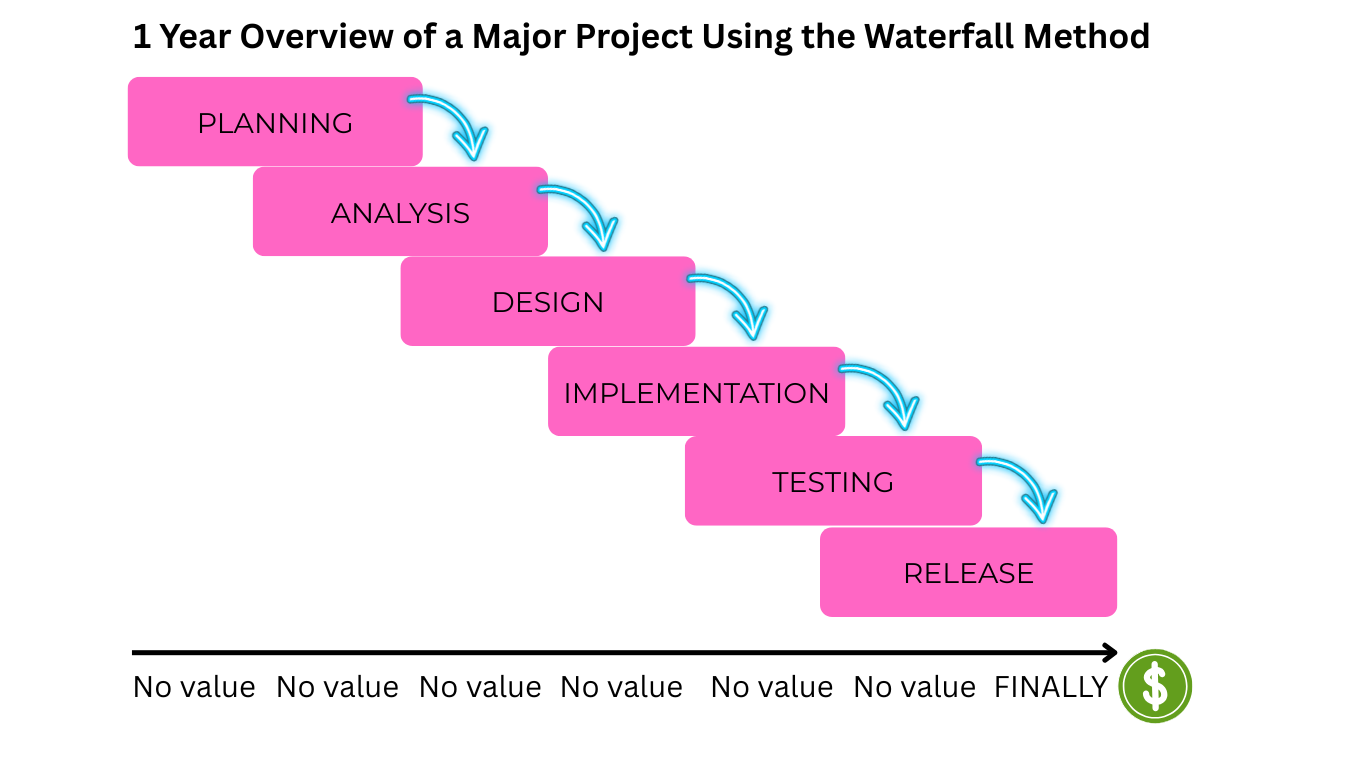
Release or Regret: Your Software Schedule is the Secret to Delivering Value
I’ve been studying to get my PSPO Certification (Professional Scrum Product Owner) by utilizing the Professional Product Owner by Don McGreal and Ralph Jocham, and I thought I’d dump a little knowledge here on my blog because, well, this is after all all about my lifestyle. It has to do with software release cycles, and while I 100% already believed in the best practice to release often, I felt it was worth it to write an entire wall of text on the subject after discussing some of these topics in my cohort (just a bunch of fellow work colleagues nerding out on this stuff).
So let’s get this party started.
Have you ever had a time in your life when you’ve been waiting for something forever and it feels close, almost ready, but it just keeps dragging on? That’s kind of what it’s like when you spend months building software, or even just updating software, and take forever to release it.
Here’s the reality that often gets overlooked by business owners, project managers, and developers: delayed delivery means delayed value. The longer you wait to release your product, the longer your stakeholders wait to see any return on investment. Every day that software sits unreleased is a day it’s not helping users, not generating revenue, and not making anyone’s life easier. You might be doing great work behind the scenes, but if it never leaves your team’s hands, it might as well not exist.
Let me say it louder for the folks in the back: until you release, you’re not delivering any value to your stakeholders. Zero. Zilch. Nada. You’re just stacking up costs, burning time, and investing hope into something that hasn’t seen the light of day.
The Myth of “It Has to Be Perfect”
A lot of teams fall into the trap of thinking, “We can’t release until all the features are there.” But here’s the kicker: software doesn’t have to be perfect to be valuable. It has to be useful. And if no one’s using it yet because it’s still sitting in your code repository or behind your QA wall, then it’s not useful to anyone but your dev team.
This is where the concept of an MVP, or Minimal Viable Product, comes in. The idea is simple: ship the smallest version of your product that still delivers value. Not all the bells and whistles. Not every edge case handled. Just enough to get it into your users’ hands, so they can start engaging, giving feedback, and helping shape what comes next.
An MVP lets you:
- Validate your core assumptions early
- Reduce development time and cost prior to generating revenue
- Start collecting feedback immediately from users
- Minimize the risk of building the wrong thing
Think of it as planting a seed instead of waiting to build the whole garden. You grow it over time, based on what your users actually want, and not what you think they want.
Shipping an MVP doesn’t mean cutting corners or delivering junk. It means being intentional, focused, and strategic about how you deliver value. It forces clarity. It encourages iteration. And most importantly, it gets you moving forward instead of spinning your wheels trying to be perfect.
Perfectly stated in The Professional Scrum Product Owner, “Because no product is ever ‘done,’ you create a series of MVPs, one after the other.” The beauty of this is as you release new iterations of your product, you are gaining new insights into what your users want, key metrics, and adding to your Product Backlog for the next MVP go round!
But wait…there’s more!
Waterfall vs Agile: The Value Showdown
Let’s talk methods. Most companies seem to operate on either a Waterfall method or an Agile method of delivery.
With the Waterfall method, releasing is the final act of the show. You spend months (or even years) planning, analyzing, designing, developing, testing, and finally, releasing. We are talking MAJOR code development, hundreds of thousands of lines of code, database development, and tons of risk to go along with that. This approach can take 12 months (or longer) to complete a single cycle. That’s a full year of investment before seeing any value, during which priorities may shift, markets may evolve, and your solution could already be outdated before it ever launches.
Each phase flows into the next like, you guessed it, a waterfall. But the problem? If something needs to change mid-stream, you’re often stuck paddling upstream, which is slow, painful, and costly. Worse than that? You don’t create any value until release…not for the users, not for the stakeholders, and not for your team trying to keep their jobs. Why keep paying people who aren’t providing value?
Agile Model:
Now contrast that with Agile. In Scrum, value delivery is built into the process from the very beginning—but that doesn’t mean we skip the foundational work. Usually, there’s an initial cycle that lasts a few months to get the MVP (Minimal Viable Product) up and running. Remember, we aren’t trying to deliver a fully feature packed product. The MVP includes the most essential features that provide core value to users and get it to them quickly.
Once that MVP is delivered, the team can shift into a rhythm of iterative development and delivery. Agile teams use short cycles called Sprints (typically one to four weeks) to build, test, and release new features. Each Sprint follows this repeatable structure:
- Implementation (Coding)
- Integration & Testing
- Deployment (Release)
I’m not even going to make a graphic to prove the point like I did with Waterfall….seriously, you are adding value for your users every 2 weeks! You don’t need a graphic to understand that. Each Sprint results in a shippable product increment. That’s right, we’re talking real, usable functionality that can be released and evaluated by stakeholders every 2 weeks. This short feedback loop allows for rapid learning, quick adjustments, and continuous delivery of value.
Why do agile teams get shit done and are some of the most productive development teams known to man? Because they deliver smaller, focused releases throughout the project lifecycle with minimal risk and maximum user happiness. This keeps stakeholders engaged and increases the chances that you’re building the right thing…also, you’re making them money, hello job security!
In all seriousness, each release isn’t just a project milestone…it’s a chance to deliver value and stay competitive. Or…you can keep waiting, lose users, lose money, and eventually lose developers who move onto more rewarding projects.
Value Lives in the Release
Just remember this…if you’re spending money and not releasing anything, what you’re really doing is delaying value. Meanwhile, your competitors might be releasing smaller updates more often, learning from their users, and building momentum. Which user base is stronger? Which software will your users recommend to their peers? The one that keeps disappointing, or the one that’s innovative and assertive?
Releasing often means you get:
- Faster feedback loops
- Better stakeholder trust
- Quicker return on investment
- Competitive advantage
And here’s a truth bomb: a feature sitting in development limbo is just a cost. A feature in production? That’s value. Users like seeing constant improvements and releases. They don’t need one major version release that has none of their feedback, and probably scattered with errors and bugs that you will have to address…hopefully before your next release in another year (Lord help us).
Don’t Sit on Your Value
You can spend months or years building the “perfect” product, but if no one sees it, uses it, or pays for it, what have you really accomplished? Release early. Release often. Learn, improve, and deliver value like a pro…or don’t…keep doing what you’re doing and let me know how that works out for you, in you know, one or two years.

Share this article
Follow me
Hey friend! Heads up: some of the links I share may earn me a small commission if you decide to buy—because mama’s gotta keep the coffee fund alive. Thanks for your support!
A quick overview of the topics covered in this article.
Latest articles
June 13, 2025
April 14, 2025




